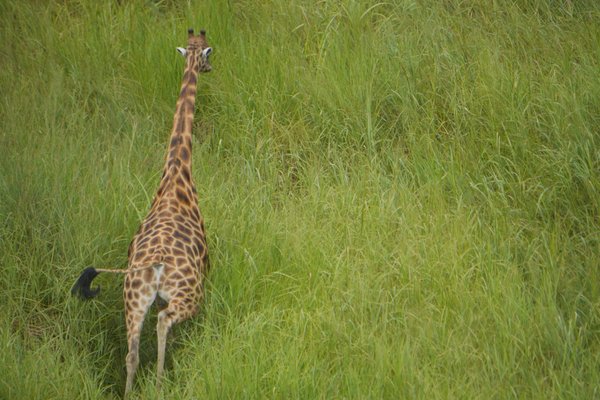Congo (Democratic Republic)
Garamba National Park
Garamba National Park comprises an area of savannah, marshland and forests that is the habitat of the world’s four largest land mammals.
The vegetation is especially suited for great herbivores such as elephants (both forest elephants and bush elephants), giraffes, hippopotamus and rhinoceros. The park aimed to protect the last known wild population of northern white rhinoceros. By 2016 it had lost all of its northern white rhinos (the species has become extinct in the wild), 95% of its elephants, most of its Kordofan giraffe and an estimated 80-90% of other large mammals
Community Perspective: Barbara reports on fieldwork she did at Garamba in the 1990s.
Site Info
Official Information
- Full Name
- Garamba National Park (ID: 136)
- Country
- Congo (Democratic Republic)
- Status
-
Inscribed 1980
Site history
History of Garamba National Park
- 2007: Reinforced Monitoring
- 1996: In Danger
- impact of the war and civil conflicts in the Great Lakes region.
- 1992: Removed from Danger list
- 1984: In Danger
- very critical situation of the white rhinoceros population, now estimated to total less than 15 specimens
- 1980: Inscribed
- Inscribed
- In Danger
- impact of the war and civil conflicts in the Great Lakes region. Since 1996
- Type
- Natural
- Criteria
- vii
- x
Links
- UNESCO
- whc.unesco.org
- Official
-
- africanparks.org — African Parks: Garamba
- Related
-
- mammalwatching.com — Mammalwatching in Garamba National Park
All Links
UNESCO.org
- whc.unesco.org — whc.unesco.org/
Official Website
- africanparks.org — African Parks: Garamba
Related Resources
- mammalwatching.com — Mammalwatching in Garamba National Park
News Article
- April 27, 2016 express.co.uk — Three park rangers killed after shootout with elephant poachers
- Jan. 20, 2016 us.blastingnews.com — Extinction looms for rare Congolese giraffes in Garamba NP
- Oct. 11, 2015 abcnews.go.com — Poachers Kill 4 in Anti-Poaching Patrol in Garamba
- Oct. 3, 2012 africajournalismtheworld.com — Chinese affluence fuels ivory poaching at Garamba
- April 25, 2012 ibtimes.co.uk — Garamba NP: 22 Elephants Massacred in Helicopter Attack
- Jan. 8, 2009 whc.unesco.org — Garamba National Park attacked by rebels, leaving 8 dead and 13 wounded
Community Information
- Community Category
- Wildlife habitat: Fauna
Travel Information
One thousand visitors or fewer
Red Zone Travel Advisory
Recent Connections
-
Named after a River
"The main rivers are the Dungu on the s… -
Red Zone Travel Advisory
DRC fully off-limits -
One thousand visitors or fewer
DD : “In 2017, a new tourist lodge was …
Connections of Garamba National Park
- Geography
-
-
Congo River Basin
-
On National Border
On South Sudan border
-
- Ecology
-
-
Rhino habitat
Northern white rhinoceros -
Otters
two species of otter -
Elephants
African elephant ("representing an intermediary form between the forest and savannah subspecies") -
Strepsirrhini
dwarf bushbaby, potto -
High-Biodiversity Wilderness Area
Congo Basin -
Hippos
"Garamba National Park contains the four largest land mammals in the world, the elephant, the rhinoceros, the giraffe and the hippopotamus." (OUV) -
Chimpanzee habitat
-
Inselbergs
“plateau … broken by inselbergs” AB ev -
Bovines
A very large population of African buffalo also display intermediary forms between the forest buffalo ... and the savannah buffalo. (OUV) -
Lions
Crit X: In addition to the rhinoceros and the giraffe, the purely savannicole species include the lion -
Swamps and Marshes
"Covering vast grass savannas and woodlands interspersed with gallery forests and marshland depressions," (OUV)
-
- Damaged
-
-
Poaching
Illegal commercial hunting over the past 45 years has resulted in significant declines of all wildlife populations in the site. At least 2,000 elephants were killed illegally between 2007 and 2012See whc.unesco.org
-
Rangers killed by poachers
See abcnews.go.com
-
- World Heritage Process
-
-
Twice on the endangered list
1984 and 1996 -
Former In Danger List sites
1984 - 1992 -
Perfect Inscriptions
1980
-
- Human Activity
-
-
African Parks Network
Since 2005 -
Papyrus
papyrus swamps
-
- WHS on Other Lists
-
-
WWF Global 200
Terrestrial, Tropical and Subtropical Grasslands, Savannas and Shrublands: (89) Sudanian SavannasSee web.archive.org
-
Centres of Plant Diversity
Af49 Garamaba National Park - "a dense network of small permanent springs that support an exceptionally high plant productivity and herbivore biomass"
-
- Timeline
-
-
Early Pleistocene
"The transition from the equatorial forest to northern latitude savannas was most probably gradual throughout the early Pleistocene"
-
- Visiting conditions
-
-
One thousand visitors or fewer
DD : “In 2017, a new tourist lodge was completed and efforts to promote tourism are ongoing. Occasional international groups do visit the park but the current climate of insecurity is a major constraint. However an important local market (>1000 expatriates working for a nearby industrial gold mining complex) is being tapped” -
Red Zone Travel Advisory
DRC fully off-limits
-
- WHS Names
-
-
Named after a River
"The main rivers are the Dungu on the southern boundary, the Aka along the western boundary and the Garamba within the Park"
-
News
- express.co.uk 04/27/2016
- Three park rangers killed after sh…
- us.blastingnews.com 01/20/2016
- Extinction looms for rare Congoles…
- abcnews.go.com 10/11/2015
- Poachers Kill 4 in Anti-Poaching P…
Recent Visitors
Community Reviews
Show full reviewsI did the field work portion of my Master's degree at Garamba in 1993 and 1995. Then, in December 1995, my husband and I got married at the Hippo Pool on the Dungu River right outside the park. We have wonderful memories from Garamba, and I understand now that the wildlife there is in grave danger and poaching has become rampant and constant. There were still lots of animals left when we were there, around 11,000 elephants and 35 rhinoceros. Now the number of elephants is down to around one thousand. Very sad, but the reality of a political system like the Congo's.
Keep reading 0 comments